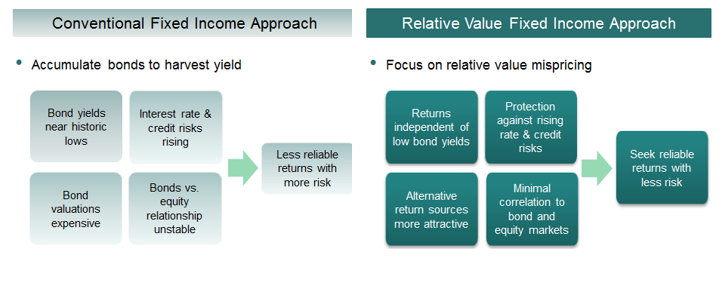There’s More to Fixed Income Than Just Buying Bonds
In fixed income investing, there are two conventional sources of return that investors are familiar with – collecting interest payments from bonds (i.e. income) and correctly predicting the direction of rates, which delivers capital gains or losses (i.e. duration exposure).
The expected returns from both these sources are heavily challenged by the current low levels interest rates and credit spreads, as well as uncertainty about their future direction.
But what if there was another source of returns that could help restore balance to fixed income portfolios? At Ardea, we believe that source of return is relative value fixed income investing.
Relative value strategies can deliver positive returns from fixed income, irrespective of the current level or future direction of rates and credit spreads.
There is a lot more to fixed income than just buying bonds and relative value strategies can access this broader range of opportunities, which conventional approaches tend to miss.
This is particularly compelling in the current environment, where conventional return sources are challenged and simply holding government bonds is no longer a reliably defensive strategy.
Conventional Fixed Income Return Sources are Challenged
For investors seeking a defensive investment, fixed income has traditionally been the asset of choice. The debt markets, by offering a senior claim over equity on the assets of a company or government can provide a safer option for investors’ capital.
In addition, bonds can provide a stable stream of income as bond issuers are contractually obliged to make regular interest payments, unlike equity dividends, which can be cut at any time.
Fixed income investments are therefore assumed to play a defensive role in portfolios.
However, three challenges currently face those reliant on fixed income to provide reliably defensive returns.
The first is that low interest rates have eroded the yield cushion in fixed income.
We can think of the income from a bond as a ‘yield cushion’ because that stream of income (or yield) helps cushion investors’ capital against losses if rates rise.
When rates are low, as they are now, the yield cushion is very thin, so you have little protection against potential capital losses.
For example, as bond yields rose in late 2016 and early 2017, 10-year Australian government bonds incurred a capital loss of around 10% over 6 months, compared to interest income of just 1.13% over the same period.
Hardly what you expect from a ‘defensive’ investment.
Add to this, central banks around the world signalling a shift away from the extreme stimulus that has kept rates suppressed since the 2008 financial crisis.
Investors are now left with an unappealing mix of low yields and rising interest rate volatility – less return for more risk.
The second is that bonds are not as reliable a risk diversifier as commonly assumed.
The conventional assumption behind balanced portfolio construction is that an allocation to bonds will provide a buffer when equity markets fall, as bond yields should decline and thus bond prices rise.
One problem with this assumption is that the starting point of bond yields is already close to zero.
The less obvious, but potentially more important issue, is that while this bond-equity correlation has held in recent history, a longer perspective shows that it’s actually quite unstable.
It is very sensitive to shifting interest rate and inflation paradigms, just like the one we’re currently seeing in the US, which is has broader implications for all bond markets around the world.
This topic is discussed in Ardea’s publication – “Does Fixed Income Still Diversify Portfolio Risk?”, available here.
The third is that ‘credit creep’ in fixed income portfolios has further compromised the defensiveness of fixed income portfolios.
The ‘reach for yield’ has been a dominant feature of financial markets for years now. In fixed income it has manifested as ‘credit creep’, meaning that allocations to higher yielding credit assets have been rising.
Of course, that higher yield comes with more risk in the form of default risk, credit spread volatility and illiquidity.
In the desperation for yield, defensive portfolios that wouldn’t normally take these types of credit related risks have been forced to become ‘credit tourists’.
In benign markets credit assets tend to perform independently of equities (i.e. they have low correlation to equities). But in times of market stress, say during a recession, they often become highly correlated and incur capital losses as equities fall … just when you need the defensiveness of your fixed income allocation the most.
This risk has been masked by current bull market conditions across both equities and credit, resulting in a build-up of hidden equity beta in fixed income portfolios that are assumed to be defensive.
Particularly concerning is the growing evidence of late cycle credit risks evident today.
For example, corporates taking advantage of cheap debt to increase borrowing, weakening creditor protection in bond and loan terms and extreme ‘reach for yield’ behaviour such as a BBB rated European company (i.e. close to high yield) being able to issue a bond with a negative yield.
That’s right, a company with real default risk being paid to borrow money!
This is the kind of behaviour you might see towards the end of a party. Seems like a good idea at the time, but the next morning not so much.
This topic is discussed in Ardea’s publication – “Corporate bonds – More Risk for Less Return”, available here.
What’s the alternative?
Conventional fixed income approaches focus on how much yield can be earned from buying and holding a bond. In contrast, a relative value approach specifically identifies whether that bond is mispriced relative to other related securities with similar risk characteristics and therefore has potential for its price to rise or fall.
A profit can then be monetised when the relative mispricing corrects, and capital can be recycled into the next opportunity.
Fixed income markets have a vast range of liquid bonds and derivatives that can be readily traded. This means a large and diverse range of such opportunities can be exploited at the same time and done so repeatedly.
This approach of rotating through many modestly sized and uncorrelated relative value positions can deliver more stable returns with lower risk than portfolios with large concentrated bets on market direction that can overwhelm a fund’s risk and return profile.
Meanwhile these positions can be isolated from unwanted market risks by using a wide range of risk management tools (e.g. interest rate derivatives).
In this way, a relative value fixed income portfolio can seek returns independent of the current level and future direction of interest rates.
Why do these opportunities exist?
Put simply, because fixed income markets are inefficient.
Underlying structural factors such as regulation, investor mandate restrictions, market segmentation, and varying investor objectives have always existed in fixed income markets.
These forces give rise to buying and selling flows that are non-economic in nature (i.e. they’re not focused on maximising profit), resulting in demand and supply imbalances that cause pricing inefficiencies.
Examples include banks managing their balance sheets, insurance companies hedging liabilities, passive investors tracking benchmarks and central banks pursuing policy objectives.
Because these drivers of market inefficiency are structural in nature, they are persistent through time and across market cycles, which makes them a reliable source of returns, around which a repeatable investment process can be built.
While none of this is new, the scope of the opportunity has been growing since 2008 due to tightening regulation on banks, increasing passive investment flows and central bank intervention.
What can relative value do for you?
A relative value approach does not rely on accumulating bonds to harvest yield or trying to predict market direction or reaching for yield in credit and is therefore not vulnerable to those challenges facing conventional return sources.
It can be implemented with very tight risk control and include specific strategies to protect against extreme negative scenarios, for example, by using interest rate options that profit from rising volatility.
The end result is the potential for stable returns exceeding cash or inflation, independent of what broader fixed income and equity markets do.
Perhaps most relevant, as relative value strategies are based on different risk and return drivers to conventional investing approaches, they provide compelling diversification benefits when used alongside traditional government bond, credit or equity investments. This is particularly useful in scenarios where those markets incur losses.
About Ardea
Ardea Investment Management is a specialist fixed income investment boutique with a focus on delivering consistent alpha to clients through an investment process supported by a highly intuitive risk system. For further information please click here
--------------------------
The information in this article has been prepared on the basis that the Client is a wholesale client within the meaning of the Corporations Act 2001 (Cth), is general in nature and is not intended to constitute advice or a securities recommendation. It should be regarded as general information only rather than advice. Because of that, the Client should, before acting on any such information, consider its appropriateness, having regard to the Client’s objectives, financial situation and needs. Any information provided or conclusions made in this article, whether express or implied, including the case studies, do not take into account the investment objectives, financial situation and particular needs of the Client. Past performance is not a guide to future performance. Neither Ardea Investment Management (“Ardea”) (ABN 50 132 902 722, AFSL 329 828), Fidante Partners Limited (“FPL”)(ABN 94 002 835 592, AFSL 234668) nor any other person guarantees the repayment of capital or any particular rate of return of the Client portfolio. Except to the extent prohibited by statute, neither Ardea nor FPL nor any of their directors, officers, employees or agents accepts any liability (whether in negligence or otherwise) for any errors or omissions contained in this article.
1 contributor mentioned


